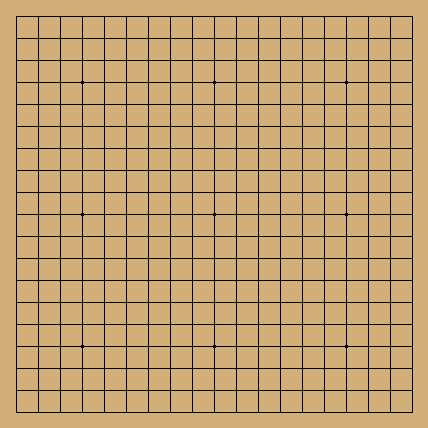How Go Captivated my Mind?
When you search on the internet for How to learn Go?, nine out of ten times, information related to GoLang will come up. That one time will be related to learning GoLang through some new, ultra super-duper intelligent artificial intelligence system that was just waiting for you.
Jokes aside, this article will not be about the Go programming language. This article will be about the game of Go, one of the most popular strategic games in Asia, a game that few people here in the West know anything about.
Just like in everything I do, I'm not an expert in this either. This is the story of a beginner who became fascinated by the patterns, connections, and symbolism of the game, and the process of overcoming oneself through the game. This is the story of how I accidentally discovered and became interested in a game called Go (Igo).
The Beginning
The homepage of my YouTube profile is filled with climbing videos. Thanks to some strange setting in some algorithm, one of the recommendations was a documentary film from 2016 - AlphaGo. I didn't know what it was about, and since I was relatively idle at that moment and craving the dopamine that the information age provides us with - I clicked on the link.
After about ten minutes, I understood what it was about. It was a documentary about how a computer succeeded in defeating a human in Go for the first time. Hmm, didn't a computer beat the world's best chess player a long time ago? What does Go have to do with it now? These were some of the questions that, truth be told, I didn't ask myself during the film. Instead, I kept watching, completely unaware of the story behind it all. As the story unfolded, I learned more.
I found out that the computer defeated a human in chess thanks to the technique of brute-force search[1] - a technique that a computer uses to solve a specific problem by trying every possible alternative before providing its final answer. But as I further learned, that's not possible in Go! Why? Because with every move in Go, it opens up over 200+ moves, then another 200+ moves. This eventually leads to an inconceivable number of possibilities. And the computer cannot find a solution using this method. A different approach must be applied. The approach of artificial intelligence.
Without going into too much detail about the film, which I highly recommend watching, I just want to briefly mention the feeling that the film evoked in me. I was fascinated. The world that was revealed to me, the culture of the game that the Far East nurtures and develops. And since I had previously been influenced by the Far East in my interests (origami, manga, anime movies, Korean cinema), it was a natural course of events for me to become interested in the game of Go.
Short History
Now a little about the history of the game (or how I copied and paraphrased everything from Wikipedia).[2]
In brief, Go is an abstract strategic board game in which two players compete for territory. The oldest written record of the game dates back to the fourth century BCE in the Chronicles of the Zuo. Later, this game was also described in Confucius's books. It was called Yi in China, and today it is known as Weiqi, which roughly translates to "encirclement board game."
According to legend, the mythical Chinese Emperor Yao (2337-2258 BCE) told his advisor Shun to design a game that would teach his son Danzhu wisdom and good behavior. Some other theories suggest that this game actually originated from Chinese tribal rulers and generals who marked positions on a map with stones to plan their attacks.
Later, this game spread to Korea (where it is called Baduk) and Japan (Igo or Go). Today, these three countries are referred to as the Three Kingdoms of Go, because in those cultures, Go is nurtured like football in England (justifiably) and football in Serbia (unjustifiably). In the Far East, it was considered one of the Four Noble Arts, alongside calligraphy, playing the lute, and painting.
"Basic" Rules
Let's compare Go with the popular game in the West - chess. Unlike chess, where each player has 16 different pieces with different movements and 6 pieces with unique movements, Go has two types of pieces called stones, which are black and white. They have the same shape. However, there are many more of these stones - 181 black and 180 white. Once a stone is placed on the board, it cannot be moved. Stones are placed on intersections, not in squares like chess pieces. The ways they move are simple - a stone is placed on an intersection and remains there. What is more complex than chess is how these stones can be combined to achieve the goal.
The goal in chess is to defeat the opponent, while in Go, the goal is to capture more territory. And that's what attracted me the most to the game - that pacifistic aspect. It's not necessarily about fighting against others (although that is also an option), but simply playing. As it often turns out, this is a game against oneself. Knowing oneself and one's only opponent, I realized that this is a good game for me.
In summary, apart from the turn order where moves are made alternately and the black player goes first, and the scoring rules, there are only two rules in Go:
- Rule of liberty - This rule states that every stone remaining on the board must have at least one open point (liberty) directly orthogonally adjacent (above, below, left, or right) or must be part of a group that has at least one liberty beside it. Stones or groups of stones that lose their last liberty are removed from the board.
- The Ko rule - It prohibits repeating a previous board position by placing stones. Such a move is forbidden for a simple reason - it would result in endless loop.
In the GIF (or /dʒɪf/, as some would say) below, there is a graphical representation of how the board and the course of the game look like.

If you want to learn more about the game and its rules, visit this YouTube channel; it's full of excellent videos and tutorials for beginners.
What next?
That's how I, thanks to the YouTube algorithm, delved into the world of Go. Whether it was accidental or not, I don't want to get into that, but I'm grateful for it. Besides the reasons I mentioned earlier, the beauty of the game itself is what kept me interested. To be honest, I still don't fully understand that beauty, and I don't know if I ever will. But I enjoy what it evokes in me and how it makes me see things from a different perspective.
If you watched and enjoyed the documentary above, here are a few more links to interesting content about the game of Go:
- An interesting and useful video about the history of the game, available on this link.
- Another documentary about the game of Go and human dedication to it.
- Lastly, but not least, there are anime and manga with Go as their main theme - Hikaru no Go.
Enjoy!

